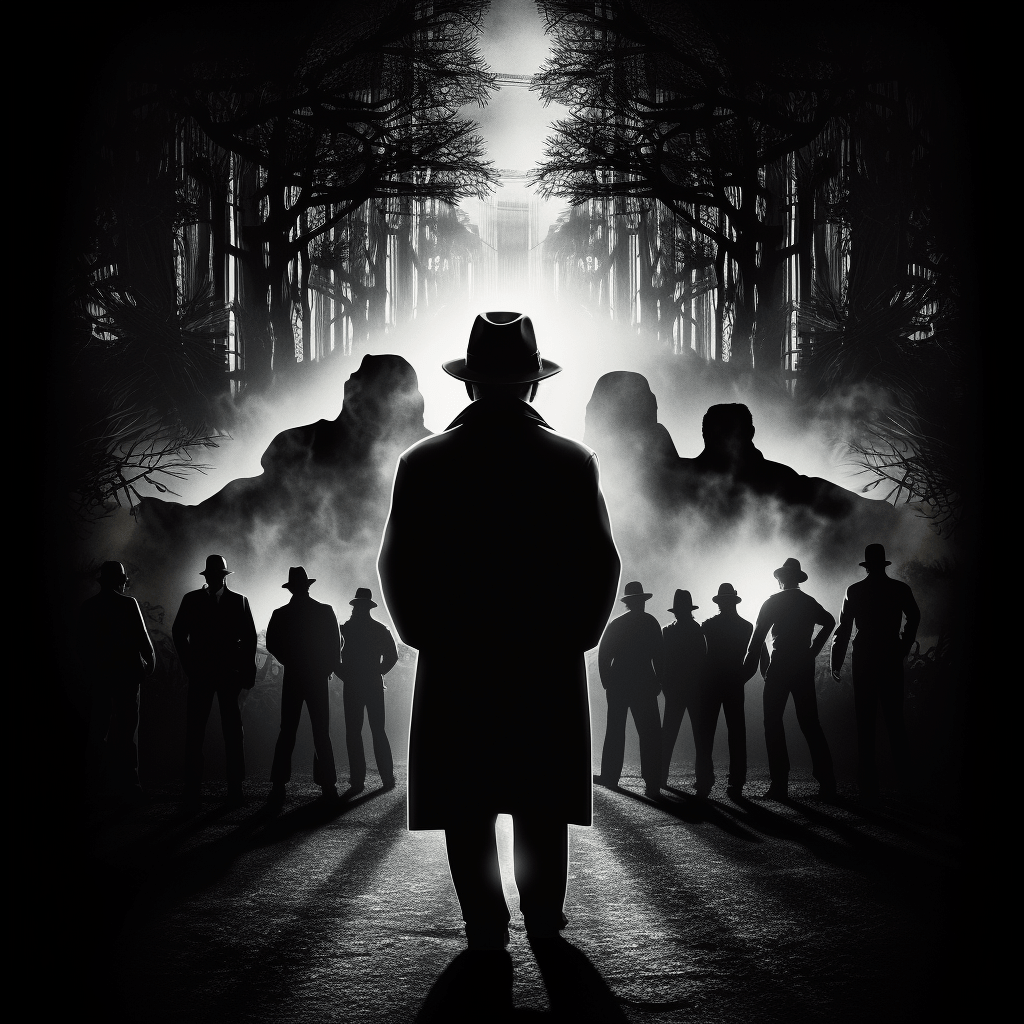Ad Blocker Detected
We use ads to keep this site running, so please consider disabling your ad blocker. Thank you!
Do not know how to disable ad blocker? Check out this article: How to disable ad blocker?
What's After the Blog?
History • Cinema
The Art of the Biopic: Telling Real-Life Stories on Screen
Explore the captivating world of biopics, their history, challenges, and impact on cinema, as we delve into how these films bring real-life stories to the screen.
February 28, 2024

Movies mentioned in this article
The Art of the Biopic: Telling Real-Life Stories on Screen
Introduction: The Power of Biopics
Biographical films, commonly known as biopics, are a unique and powerful genre in the cinematic world. They offer a captivating blend of factual history and creative storytelling, inviting audiences to explore the lives of influential figures, inspiring leaders, and extraordinary individuals. The essence of a biopic lies in its ability to humanize these larger-than-life characters, making their stories accessible and relatable to viewers.
The significance of biopics extends beyond mere entertainment. These films serve as windows into different eras, cultures, and pivotal moments in history. They breathe life into historical narratives, often shedding light on untold stories or providing new perspectives on well-known events. For instance, the film Lincoln offers a profound glimpse into the presidency of Abraham Lincoln, delving into his leadership during the American Civil War. Similarly, The Imitation Game introduces audiences to the enigmatic genius of Alan Turing and his pivotal role in World War II.
Biopics also play a crucial role in preserving and interpreting history. By dramatizing real-life events and personalities, these films make history tangible and engaging. They encourage viewers to reflect on the human experiences behind historical facts, fostering a deeper understanding and empathy. For example, the harrowing narrative of Solomon Northup in 12 Years a Slave not only recounts his experience but also offers a visceral portrayal of slavery in America.
However, the power of biopics also lies in their narrative and artistic interpretation. Filmmakers often face the challenge of balancing historical accuracy with compelling storytelling. This balance is crucial in crafting a film that is both informative and emotionally resonant. The artistic liberties taken in biopics, whether in character portrayal or the condensation of events, are vital in weaving a narrative that captivates the audience while honoring the essence of the real-life story.
The History and Evolution of Biopics
The genre of biopics has a rich and varied history, evolving significantly over the years. The earliest biopics often focused on historical figures and national heroes, serving as a means of moral instruction and inspiration. These early films were characterized by their straightforward narratives and emphasis on the achievements and virtues of their subjects. A classic example is the 1936 film The Story of Louis Pasteur, which chronicles the life of the renowned scientist and his fight against scientific skepticism.
As the genre matured, filmmakers began to explore more complex and nuanced portrayals of their subjects. This shift was partly influenced by changing social attitudes and a growing interest in psychological depth. Biopics started to delve into the personal struggles, moral dilemmas, and inner conflicts of their protagonists, offering a more rounded and humanized depiction. Films like Lawrence of Arabia and Gandhi are emblematic of this era, showcasing the intricate personalities and multifaceted lives of their respective figures.
In recent years, the biopic genre has continued to evolve, embracing diverse subjects and unconventional storytelling techniques. Modern biopics often focus on lesser-known figures, bringing marginalized stories to the forefront. These films challenge traditional narratives, offering fresh perspectives and highlighting the contributions of individuals who might have been overlooked in mainstream history. For example, Hidden Figures celebrates the vital but previously unrecognized role of African American women mathematicians in NASA during the Space Race.
Furthermore, contemporary biopics are increasingly experimenting with narrative structure, visual style, and thematic complexity. Directors are blending genres, incorporating elements of drama, comedy, and even fantasy
to create a more dynamic and engaging viewer experience. Films like I, Tonya employ a mockumentary style, blending dark comedy with drama to recount the controversial career of figure skater Tonya Harding. This approach allows for a more multifaceted portrayal of the subject, challenging the audience’s preconceptions and inviting them to see the story from multiple angles.
This evolution reflects the growing sophistication of audiences and their desire for stories that are not just informative, but also emotionally and intellectually stimulating. Biopics today are not just about recounting events or glorifying individuals; they are about exploring the complexities of the human condition, the ambiguities of history, and the nuances of personal experience. They invite viewers to question and reflect, to empathize with characters who are flawed and multifaceted, and to understand the past in a more profound and meaningful way.
In conclusion, the power and appeal of biopics lie in their ability to bring history to life, to humanize figures we may only know from textbooks, and to tell stories that are as diverse and complex as humanity itself. Whether they are portraying historical icons, unsung heroes, or controversial figures, biopics offer a unique lens through which we can view the past and, in turn, gain insights into our present and future.
Crafting a Compelling Narrative: The Challenges of Biopics
“Why is it challenging to adapt real-life stories into movies?” This question lies at the heart of biopic filmmaking. Crafting a compelling narrative from real-life events is a delicate balancing act. Filmmakers must navigate the intricacies of historical accuracy, ethical storytelling, and cinematic appeal. The challenge is to distill a lifetime of experiences, or a significant historical event, into a two-hour film that is both engaging and respectful to the truth.
One of the primary challenges is selecting which aspects of a person’s life or which events to include. Real lives don’t follow neat narrative arcs and often contain complexities that can be difficult to convey within the constraints of a film. For example, the biopic Steve Jobs focuses on three pivotal moments in the life of the Apple co-founder, eschewing a traditional chronological narrative to capture the essence of his character and career. This selective approach can be effective in highlighting key themes and moments, but it also raises questions about what is omitted and how these choices affect the audience’s perception of the subject.
Another challenge is the portrayal of the central character. Biopics require a nuanced depiction that captures the complexities of the subject. This often involves portraying both their achievements and their flaws, creating a multi-dimensional character that is relatable and human. In films like Capote, the audience is presented with a character who is at once brilliant and deeply flawed. Such portrayals can be controversial, especially when dealing with beloved or infamous figures, as they can challenge the audience’s preconceived notions.
Moreover, filmmakers must often condense events and characters for narrative efficiency, which can lead to accusations of historical inaccuracy or oversimplification. The task of faithfully representing a person’s life, while also creating an engaging cinematic experience, is a complex and often contentious process. The biopic A Beautiful Mind, while critically acclaimed, faced criticism for its departure from the finer details of John Nash’s life and experiences.
Memorable Biopics and Their Impact
Biopics have the power to leave a lasting impact on audiences, often shaping our understanding of historical figures and events. They bring history to life, making it accessible and emotionally resonant. Some biopics become cultural landmarks, not only due to their artistic merits but also because of the way they influence public perception and dialogue about their subjects.
- Schindler’s List (Schindler’s List): This film brought the story of Oskar Schindler and his role in saving Jewish lives during the Holocaust to a wide audience. Its stark portrayal of the horrors of the Holocaust and the moral complexities of Schindler’s actions had a profound impact on public awareness and understanding of these historical events.
- The King’s Speech ([The King’s Speech](
MOVIE_LINK)): This film offers a personal glimpse into the life of King George VI and his struggle to overcome a speech impediment. It humanizes a historical figure, often perceived as distant or unrelatable, and highlights the personal challenges faced by those in positions of power. The film’s focus on King George’s relationship with his speech therapist adds a deeply human dimension to the portrayal of monarchy and leadership.
- Bohemian Rhapsody (Bohemian Rhapsody): This biopic celebrates the life of Freddie Mercury, lead vocalist of Queen, showcasing his musical genius as well as his personal struggles. The film’s vibrant portrayal of Mercury’s life and its exploration of his identity and relationships brought a new level of recognition and understanding of this iconic figure to a broader audience.
Each of these films exemplifies the biopic’s ability to not only recount historical events or the lives of individuals but also to engage with deeper themes such as morality, identity, and the human spirit. They demonstrate how biopics can contribute to cultural memory and dialogue, influencing how we perceive historical figures and past events.
Biopics like these also highlight the ethical responsibilities filmmakers bear when depicting real lives and events. The choices made in narrative, characterization, and thematic emphasis can have a significant impact on how subjects are remembered and understood. This power to shape collective memory and public discourse is what makes biopics a uniquely influential genre in the world of cinema.
In essence, the enduring appeal of biopics stems from their ability to bridge the gap between history and story, fact and narrative. They provide a window into the lives of extraordinary individuals, allowing us to experience their journeys, empathize with their struggles, and celebrate their achievements. Through these films, we gain a deeper understanding of the complex tapestry of human experience and the myriad ways in which individual lives can shape and be shaped by the course of history.
The Role of Research and Authenticity
“How do filmmakers ensure authenticity in biopics?” This question underscores the crucial role of research in the creation of biographical films. Authenticity is the cornerstone of any biopic, as it provides the foundation upon which a believable and respectful portrayal of real-life figures and events is built. Filmmakers, therefore, embark on extensive research, delving into historical documents, biographies, interviews, and sometimes even personal diaries or letters to gain a comprehensive understanding of their subjects.
Research in biopics serves several essential purposes. Firstly, it ensures factual accuracy, providing filmmakers with a detailed framework of the events and personalities they are depicting. For example, the biopic Selma involved meticulous research into the civil rights movement and the life of Martin Luther King Jr., ensuring an accurate representation of the historical context and the figures involved. Secondly, research helps in recreating the settings and atmosphere of the time, which is vital in immersing the audience in the narrative. Films like The Aviator, chronicling the life of Howard Hughes, demonstrate the importance of accurately depicting the era’s aesthetic and cultural nuances.
However, the pursuit of authenticity in biopics is not without its challenges. Filmmakers often have to navigate the fine line between historical accuracy and dramatic storytelling. While staying true to the facts is important, biopics also need to engage the audience emotionally and narratively. This balancing act can lead to creative liberties in the representation of events and characters. For instance, in Amadeus, while the rivalry between Mozart and Salieri is dramatized for cinematic effect, the film captures the essence of Mozart’s genius and the period’s artistic fervor.
The ethical considerations in portraying real people, particularly those who are no longer alive to provide their own perspective, are also a significant aspect of the research process. Filmmakers must navigate these ethical waters carefully, ensuring that their portrayal is respectful and does not unfairly distort the subject’s legacy. This responsibility is evident in biopics like Frida, which thoughtfully portrays the life and art of Frida Kahlo, balancing her personal struggles with her artistic achievements.
Performance and Characterization: Bringing Icons to Life
The success of a biopic often hinges on the performance of its lead actors. Their ability to convincingly portray real-life figures is crucial in bringing these stories to life. This task requires a deep understanding of the character, often involving extensive research into their lives, mannerisms, speech patterns, and even psychological makeup. Actors in biopics must not only resemble their real-life counterparts physically but also capture their essence, a challenge that requires both skill and sensitivity.
Notable performances in biopics are numerous and varied, each offering a unique insight into the life of the character portrayed. For example, Daniel Day-Lewis’s portrayal of Abraham Lincoln in Lincoln is lauded for its authenticity and depth, capturing not just the physical appearance of the former president but also his temperament, speech, and leadership style. Similarly, Marion Cotillard’s performance in La Vie en Rose as Edith Piaf is remarkable for its emotional intensity and transformation, bringing the iconic singer’s turbulent life and career to the screen with poignant realism.
These performances often require actors to undergo significant physical and emotional transformations. They might spend months researching their characters, adopting their mannerisms, and even learning new skills or languages. This immersive approach helps actors to deliver performances that are not only convincing but also deeply empathetic, allowing audiences to
connect with the characters on a more profound level.
The portrayal of complex and multifaceted individuals also presents a challenge for actors. They must navigate the intricacies of their character’s personality, often portraying a range of emotions and states of mind. In biopics like The Theory of Everything, where Eddie Redmayne portrays Stephen Hawking, the actor must convey the physical challenges of Hawking’s condition as well as his brilliant mind and spirit. This kind of performance demands a high level of skill and dedication, as it involves representing both the vulnerabilities and strengths of the character.
Furthermore, the portrayal of controversial or less-known figures requires a delicate balance between interpretation and respect. Actors often have the task of humanizing these figures, presenting them in a light that reveals their humanity beyond their public persona. This aspect of performance in biopics can sometimes lead to new public understandings or discussions about the figures portrayed, as seen in the film Monster, where Charlize Theron’s portrayal of serial killer Aileen Wuornos challenges viewers to consider the complexity of her life and circumstances.
In essence, the role of performance in biopics is pivotal. Through their portrayals, actors bring depth and nuance to the characters they play, bridging the gap between historical figures and the audience. Their performances not only contribute to the film’s overall authenticity but also play a crucial role in how these figures are remembered and understood by future generations. The best biopic performances leave a lasting impression, transforming our perception of the characters and the times they lived in.
The Future of Biopics in Cinema
The future of biopics in cinema is as dynamic and promising as the genre’s past. As audiences become more sophisticated and diverse, the demand for innovative storytelling and fresh perspectives in biopics is increasing. This evolution is likely to be characterized by several key trends and directions that will shape the genre in exciting new ways.
One significant trend is the shift towards exploring lesser-known figures and untold stories. While biopics have traditionally focused on well-known personalities, there is a growing interest in bringing the stories of lesser-known but equally influential individuals to the forefront. This shift not only broadens the genre’s scope but also offers opportunities to explore diverse cultures, histories, and perspectives. For instance, films like Hidden Figures and The Immortal Life of Henrietta Lacks highlight important but previously overlooked contributions to history.
Another trend is the use of innovative narrative techniques and visual storytelling. Filmmakers are increasingly experimenting with non-linear narratives, mixed media, and even virtual reality to create more immersive and impactful biopics. This experimentation with form and style not only makes the genre more engaging but also allows for more creative and nuanced interpretations of real-life stories. Biopics like I, Tonya and Vice exemplify this trend with their unconventional approaches to storytelling.
Furthermore, the integration of new technologies and platforms is likely to play a significant role in the future of biopics. Streaming services are already becoming a major platform for biographical films, offering filmmakers more creative freedom and the opportunity to reach wider audiences. The rise of serialized biopics in the form of mini-series or episodic content on these platforms allows for deeper and more detailed exploration of characters and events. This format can be seen in series like The Crown and Chernobyl, which offer extensive and intricate depictions of historical events and figures.
The future of biopics also holds the potential for greater collaboration and interaction with audiences. With the rise of social media and digital platforms, filmmakers have new opportunities to engage with viewers, gain insights, and even crowdsource ideas for biopic subjects. This interaction can lead to more diverse and inclusive storytelling, reflecting a broader range of experiences and perspectives.
In summary, the future of biopics is marked by innovation, diversity, and interaction. As the genre continues to evolve, it will undoubtedly continue to captivate audiences with powerful and insightful portrayals of real-life stories, contributing to a richer and more diverse cinematic landscape
.
Conclusion: The Enduring Appeal of Biopics
In conclusion, the enduring appeal of biopics stems from their unique ability to connect us with the past, illuminate the present, and inspire the future. These films offer more than just entertainment; they provide a deeper understanding of the human experience, showcasing the triumphs, struggles, and complexities of real people and events. Through the art of biopics, filmmakers bring history to life, creating a lasting impact on audiences and society at large.
The significance of biopics in cinema is multifaceted. They serve as educational tools, offering insights into historical events and figures, and as sources of inspiration, highlighting the resilience and achievements of individuals. The emotional resonance of these stories, combined with the artistic expression of filmmakers and actors, makes biopics a powerful genre that transcends time and culture.
As we look to the future, biopics will continue to evolve, reflecting changes in society, technology, and storytelling techniques. This evolution promises to bring even more diverse and compelling stories to the screen, broadening our understanding of the world and the people who have shaped it. Whether exploring the lives of historical icons, unsung heroes, or controversial figures, biopics will remain an integral part of cinema, captivating audiences with their portrayal of real-life stories.
We invite you to explore more about the art of cinema and the fascinating world of movies through our blog at What’s After the Movie. From behind-the-scenes insights to in-depth analyses of genres like biopics, our blog offers a rich array of content for movie enthusiasts and casual viewers alike. Join us as we continue to delve into the stories behind the screen and celebrate the magic of film.
Continue reading

What's After the Movie?
Not sure whether to stay after the credits? Find out!
Check out our other apps:
Actors
Companies
Latest Movies
© 2025 What's After the Movie. All rights reserved.




























